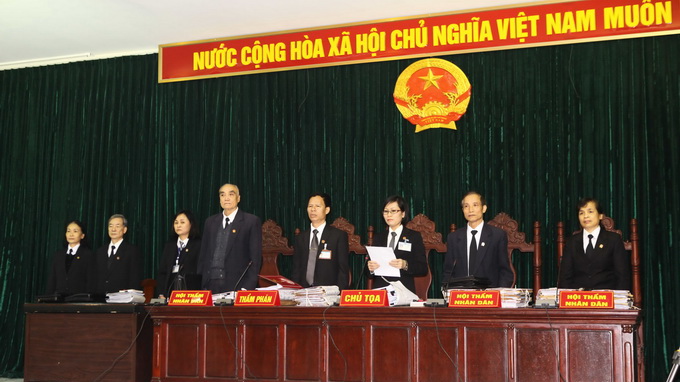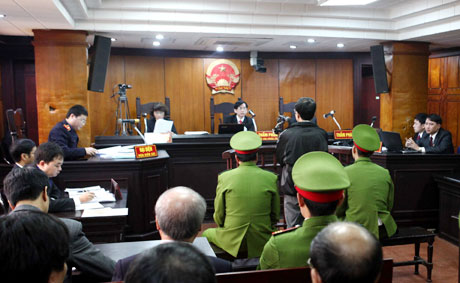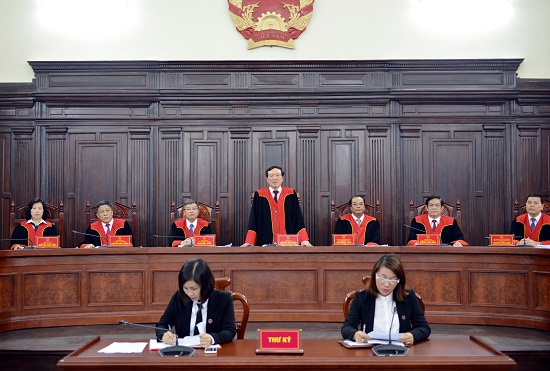Supreme People's Court: Highest judicial body of the Socialist Republic of Vietnam
According to regulations, the Supreme People's Court is the highest judicial body of the Socialist Republic of Vietnam. So how does Vietnamese law regulate the duties, powers and organizational structure of this agency?
According to Article 21 of the Law on Organization of People’s Courts 2014 of Vietnam, the organizational structure of the Supreme People’s Court consists of:
- The Judicial Council;
- The assisting apparatus;
- Training institutions.
The Supreme People’s Court has the Chief Justice, Deputy Chief Justices, judges, examiners, court clerks, other civil servants, public employees and employees.

Duties and powers of the Supreme People’s Court are specified as follows:
- The Supreme People’s Court shall review according to cassation or reopening procedure in accordance with the procedural law judgments and decisions of courts which have taken legal effect and are protested against.
- To supervise the adjudicating work of other courts, except cases prescribed by a law.
- To make overall assessment of adjudicating practices of courts, ensuring the uniform application of law in trial.
- To train and retrain judges, assessors and other staff of people’s courts.
- To manage people’s courts and military courts organizationally in accordance with this Law and relevant laws, ensuring independence of courts from one another.
- To submit to the National Assembly draft laws and resolutions; to submit to the National Assembly Standing Committee draft ordinances and resolutions in accordance with law.
Besides, according to Article 22 of the Law on Organization of People’s Courts 2014 of Vietnam, Judicial Council of the Supreme People’s Court is specified as follows:
- The number of members of the Judicial Council of the Supreme People’s Court must be between thirteen and seventeen, including the Chief Justice, Deputy Chief Justices being judges of the Supreme People’s Court and other judges of the Supreme People’s Court.
- The Judicial Council of the Supreme People’s Court has the following duties and powers:
+ To review according to cassation or reopening procedure in accordance with the procedural law judgments and decisions of courts which have taken legal effect and are protested against;
+ To issue resolutions to guide courts in uniformly applying law;
+ To select its cassation trial decisions and judgments and decisions of courts which have taken legal effect and are of standard nature, summarize and develop them into court precedents and publicize court precedents for courts to study and apply in trial;
+ To discuss and give its opinions on reports of the Chief Justice of the Supreme People’s Court on people’s courts’ work for submission to the National Assembly, National Assembly Standing Committee and President;
+ To give its opinions on draft laws and resolutions for submission to the National Assembly, and draft ordinances and resolutions for submission to the National Assembly Standing Committee;
+ To discuss and give its opinions on draft legal documents falling under the promulgating competence of the Chief Justice of the Supreme People’s Court and draft legal documents to be jointly promulgated by the Supreme People’s Court and related agencies in accordance with the Law on Promulgation of Legal Documents.
- A meeting of the Judicial Council of the Supreme People’s Court shall be attended by at least two-thirds of its total members. Decisions of the Judicial Council of the Supreme People’s Court shall be voted for by more than half of its total members.
- The Procurator General of the Supreme People’s Procuracy and the Minister of Justice shall attend meetings of the Judicial Council of the Supreme People’s Court where resolutions of the Judicial Council of the Supreme People’s Court are discussed and adopted.
- Cassation or reopening trial decisions of the Judicial Council of the Supreme People’s Court are the highest and cannot be protested against.
- Number of deputy directors of departments in Vietnam in accordance with Decree 45/2025/ND-CP
- Cases ineligible for pardon in Vietnam in 2025
- Decree 50/2025 amending Decree 151/2017 on the management of public assets in Vietnam
- Circular 07/2025 amending Circular 02/2022 on the Law on Environmental Protection in Vietnam
- Adjustment to the organizational structure of the Ministry of Health of Vietnam: Certain agencies are no longer listed in the organizational structure
- Vietnam aims to welcome 22-23 million international tourists in Vietnam in 2025
-
.jpg)
- Vietnam’s judge ranks: Conditions for appointment ...
- 10:00, 20/12/2017
-

- Vietnam: Assurance of operation of People’s Courts
- 10:43, 27/09/2017
-

- Duties, powers and organizational structures of ...
- 09:54, 20/08/2017
-

- People’s Courts of Vietnam: Basic issues
- 09:00, 30/12/2016
-
.jpg)
- Vietnam: Some basic new points about the organizational ...
- 12:06, 11/07/2015
-

- Notable new policies of Vietnam effective as of ...
- 16:26, 11/04/2025
-
.Medium.png)
- Notable documents of Vietnam in the previous week ...
- 16:21, 11/04/2025
-
.Medium.png)
- Notable documents of Vietnam in the previous week ...
- 16:11, 02/04/2025
-
.Medium.png)
- Notable new policies of Vietnam to be effective ...
- 16:04, 02/04/2025
-
.Medium.png)
- Notable new policies of Vietnam effective from ...
- 14:51, 21/03/2025
 Article table of contents
Article table of contents
